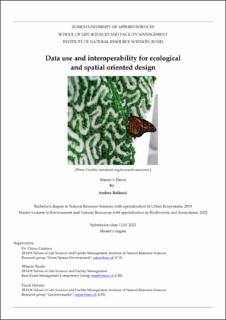Please use this identifier to cite or link to this item:
https://doi.org/10.21256/zhaw-25125Full metadata record
| DC Field | Value | Language |
|---|---|---|
| dc.contributor.advisor | Catalano, Chiara | - |
| dc.contributor.advisor | Meslec, Mihaela | - |
| dc.contributor.advisor | Ochsner, Pascal | - |
| dc.contributor.author | Balducci, Andrea | - |
| dc.date.accessioned | 2022-06-13T14:55:49Z | - |
| dc.date.available | 2022-06-13T14:55:49Z | - |
| dc.date.issued | 2022 | - |
| dc.identifier.uri | https://digitalcollection.zhaw.ch/handle/11475/25125 | - |
| dc.description.abstract | Fragmentation, degradation, and loss of habitats have caused serious loss of biodiversity. Urbanization especially is exerting an increased social, health, infrastructural and environmental pressure on urban ecosystems. In fact, the eco-logical footprint of urban areas is set to increase in the coming decades, additionally exacerbated by the effects of climate change. While urbanization and the expansion of the built environment have currently a negative impact on biodiversity, they also represent the greatest opportunity to integrate the promotion of biodiversity into development projects. This is an opportunity to be grasped by the AEC industry to design integrated eco-services and to eco-retrofit our cities, as well as to actively integrate biodiversity conservation into urban planning processes. At the same time, there is still uncertainty on what could be the drivers and incentives for planners and architects to implement such ecological and spatial oriented designs. There is a need of a new way of integrating ecological knowledge early in the design processes, that is focused more on interdisciplinary cooperation and on the integration in the built environment of biodiversity and wildlife inclusive sensitive designs. This thesis investigates the interdisciplinary cooperation and the ecological data interoperability, by seeking opinions of the AEC sector workers, teachers and students, through an online questionnaire about the awareness and readiness towards adopting sustainable and most importantly ecological and biodiversity improving project designs. Furthermore, it investigates the feasibility of developing, through parametric design, a façade integrated target species promoting BIM element. The modeling and parametrization were developed using Revit Architecture, a popular BIM software, whereas Dynamo, a visual programming environment, was used to test the interaction capabilities of such element in relation with its parameters and the ecological information. This thesis is intended, on one hand to improve the interdisciplinary exchange and understanding of ecological information and on the other to explore a way of creating a façade integrated BIM element, that can be adapted and modified in real time in correlation with the dimensions of a selected target species. Thereby providing ecologists, architects and planners with the knowledge and tools to maximize cooperation and the biodiversity potential of their designs. | de_CH |
| dc.format.extent | 52 | de_CH |
| dc.language.iso | en | de_CH |
| dc.publisher | ZHAW Zürcher Hochschule für Angewandte Wissenschaften | de_CH |
| dc.rights | https://creativecommons.org/licenses/by/4.0/ | de_CH |
| dc.subject | Sustainable development | de_CH |
| dc.subject | Sustainable building | de_CH |
| dc.subject | Urban ecology | de_CH |
| dc.subject | Biodiversity | de_CH |
| dc.subject | Holistic design | de_CH |
| dc.subject | Design with Nature | de_CH |
| dc.subject | Ecological oriented design | de_CH |
| dc.subject | Revit | de_CH |
| dc.subject | Parametric design | de_CH |
| dc.subject | Integrated biodiversity measure design | de_CH |
| dc.subject.ddc | 333.7: Landflächen, Naturerholungsgebiete | de_CH |
| dc.subject.ddc | 577: Ökologie | de_CH |
| dc.title | Data use and interoperability for ecological and spatial oriented design | de_CH |
| dc.type | Thesis: Master | de_CH |
| dcterms.type | Text | de_CH |
| zhaw.departement | Life Sciences und Facility Management | de_CH |
| zhaw.publisher.place | Winterthur | de_CH |
| dc.identifier.doi | 10.21256/zhaw-25125 | - |
| zhaw.originated.zhaw | Yes | de_CH |
| Appears in collections: | Masterarbeiten Umwelt und Natürliche Ressourcen | |
Files in This Item:
| File | Description | Size | Format | |
|---|---|---|---|---|
| 2021_Balducci_Andrea_MAS_ENR.pdf | 4.1 MB | Adobe PDF |  View/Open |
Show simple item record
Balducci, A. (2022). Data use and interoperability for ecological and spatial oriented design [Master’s thesis, ZHAW Zürcher Hochschule für Angewandte Wissenschaften]. https://doi.org/10.21256/zhaw-25125
Balducci, A. (2022) Data use and interoperability for ecological and spatial oriented design. Master’s thesis. ZHAW Zürcher Hochschule für Angewandte Wissenschaften. Available at: https://doi.org/10.21256/zhaw-25125.
A. Balducci, “Data use and interoperability for ecological and spatial oriented design,” Master’s thesis, ZHAW Zürcher Hochschule für Angewandte Wissenschaften, Winterthur, 2022. doi: 10.21256/zhaw-25125.
BALDUCCI, Andrea, 2022. Data use and interoperability for ecological and spatial oriented design. Master’s thesis. Winterthur: ZHAW Zürcher Hochschule für Angewandte Wissenschaften
Balducci, Andrea. 2022. “Data Use and Interoperability for Ecological and Spatial Oriented Design.” Master’s thesis, Winterthur: ZHAW Zürcher Hochschule für Angewandte Wissenschaften. https://doi.org/10.21256/zhaw-25125.
Balducci, Andrea. Data Use and Interoperability for Ecological and Spatial Oriented Design. ZHAW Zürcher Hochschule für Angewandte Wissenschaften, 2022, https://doi.org/10.21256/zhaw-25125.
Items in DSpace are protected by copyright, with all rights reserved, unless otherwise indicated.